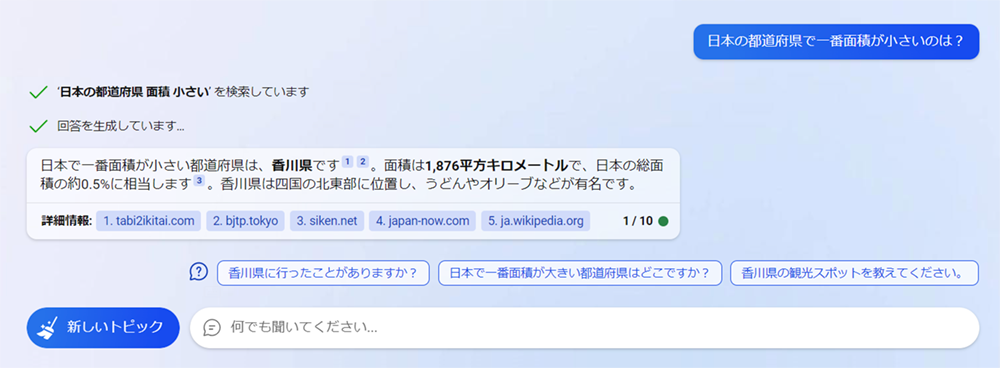こんにちは。電通グループのAI活用を推進する「AI MIRAI」統括の児玉です。今、各所で話題になっている生成AI。本連載では生成AIがマーケティングに与える影響を3回にわたり解説していきます。
第2回は、チャット検索や、その他の対話AIがどのように生活者行動を変えるか?を考えていきたいと思います。
チャット検索とは?
前回の記事で、マーケティングに大きな影響を与える可能性がある技術のひとつとして、チャット検索を挙げました。
チャット検索について簡単に説明すると、従来の「関連するウェブサイトを提示する」という検索エンジンとは異なり、こちらからの問いかけに対し、ウェブ上をクローリングして情報を集め、つなぎあわせて問いかけの回答のみを返答してくれるサービスです。

チャット検索の例(Microsoft Bing)
これによりユーザーは、ウェブサイトを巡回・閲覧することなく必要な情報をすぐに入手できる、というサービスになっています。2023年3月時点で代表的なものはMicrosoft Bingですが、GoogleもBardという同様のチャット検索サービスを発表していますし、他にもスタートアップによるサービスがいくつか展開されており、競争が始まっています。
チャット検索の何が便利なのか?
私も日々、チャット検索を使っているのですが、従来の検索とは違った便利さがあるように感じています。いくつかメリットを紹介します。
操作が少なくて済む。
従来の検索では、必要な情報にたどり着くまでに、「検索クエリ(検索ワード)を考える」「ウェブサイト一覧から適切なものを選ぶ」「サイトから情報を探す」というステップが必要でした。
ところがこのチャット検索では、こちらから指示すれば、必要な情報だけをシンプルに提示してくれます。操作が圧倒的に少なくてすむのです。

情報入手に必要な操作が圧倒的に少ない。
ひとつの動作で複数サイトを比較できる。
従来であればウェブサイトを複数巡回して調べる必要があったが、一つの動作で情報収集が可能です。現状はまだ完璧とはいえませんが、情報収集がますます楽になっています。

複数の情報源を横断して調べることができ、表の形式でも表示可能
ノイズが少ない。
今までの検索画面やウェブサイトには、入手したい情報と関係が薄い検索結果、他のページへのリンク、広告などが多数含まれています。一方で(少なくとも現時点の)チャット検索にはそれらがなく、閲覧するときの認知負荷が少なくなっています。
このため個人的には、打ち合わせをしながらや、作業しながらなど、「ながら検索」をしたいときに会話や作業の手を止めずに情報を入手することができるのが便利だと感じます。
チャット検索の弱点。
一方、最大の弱点は、情報の正確性に欠けることです。ChatGPTなどほかの言語生成AIもそうですが、その技術特性上、誤情報を提示する可能性があります。現時点でも日々バージョン更新が行われているようですが、まだ誤情報提示の可能性はゼロにはできていませんし、おそらくどこまでいってもゼロにはならないと考えられます。
では、通常の検索では誤情報はないのでしょうか。そんなことはありません。インターネット上の情報は、正しいものもあれば、間違っているもの、古いものも混在しています。そして、それらを見分けるためのテクニックを「検索のテクニック」として、現代の私たちは身に付けているわけです。ゆくゆくはチャット検索についても、誤情報を見分けたり、減らしたりするためのテクニックが確立されていくでしょう。
まだまだサービスとして粗削りに見える部分もありますが、少なくとも現時点では、従来の検索と違った特徴をもっており一定の評価はされている、という印象です。
チャット検索により、情報接触はどう変わるのか。
では、仮にこれらのチャット検索が一定のシェアを持ったとき、生活者の情報接触において何が変わるのでしょうか。
サイト来訪という行為の減少
情報接触がチャット検索で完結し、ウェブサイトを訪れることがなくなる、という可能性があるのです。チャット検索は、こちらからの問いかけに対して、おすすめ商品を提示し(認知獲得)、詳細情報を掘り下げ(興味喚起)、他商品と比較し(比較検討)、購買までの動線のすべてをチャット検索上で達成することができます。
これはかなり衝撃的ではないでしょうか。検索し、ランディングページを訪れたユーザーにコンバージョンを促す、という従来の情報接触のステップは塗り替えられてしまうかもしれません。また、一連の動作で得ていたユーザーの行動データなどが把捉できなくなってしまう可能性もあります。

カスタマージャーニーがチャット検索で完結してしまう
企業やブランドの窓口の一本化
一方でチャットボット技術の進化は、企業にとって大きなチャンスにもなります。多様な情報を自在にあやつれるチャットボットが構築できるようになると、今まで分かれていた顧客接点、例えばカタログ・営業・チュートリアル・アフターサービスなどの窓口を、ひとつのチャットボットに集約させることができるかもしれません。
そして、チャットボットには、“人格”を持たせることができます。企業やブランドにあわせたチャットボットを設置し、そのブランドらしい語り口で、接客、営業、サポートを行う……そんなことが可能になると考えられます。
情報と体験の分離
チャット検索により、単なる「情報」であれば、AIが抜き出すことができます。つまり、単なる情報をいくら企業が自社ウェブサイトに魅力的な形に配置しても、ユーザーはそれを読まなくなる可能性がある、ということです。情報をAIにスムーズに読ませるための最適化技術(現在のSEOに相当)も、今後登場するかもしれません。
一方で、先に書いたとおり窓口を一本化しキャラクター化すると、その価値は「体験」「サービス」と呼べそうです。
つまり、情報はチャット検索経由で流通させ、体験・サービスはチャットボットで確立させる、という「情報と体験の分離」が起こってくると考えられます。別の言い方をすれば、「ウェブサイトからウェブサービスへ」となるでしょうか。

「情報」と「体験」が分離していく
カスタマージャーニーは変わり続ける
この記事では、カスタマージャーニーの変化の可能性をご紹介しましたが、チャット検索やチャットボットだけが顧客体験を変えるわけではありません。また、私たちが思いもよらないような新しい技術やサービスが登場し、まったく違うシナリオをたどる可能性だって十分あると考えられます。マーケターは、技術と生活者の進歩につねに敏感でなくてはならないと感じます。
次回の記事では、生成AIが当たり前の時代に、マーケターやクリエイターはどう進歩していくのか、というテーマで考えてみたいと思います。

カスタマージャーニーは変わり続ける

